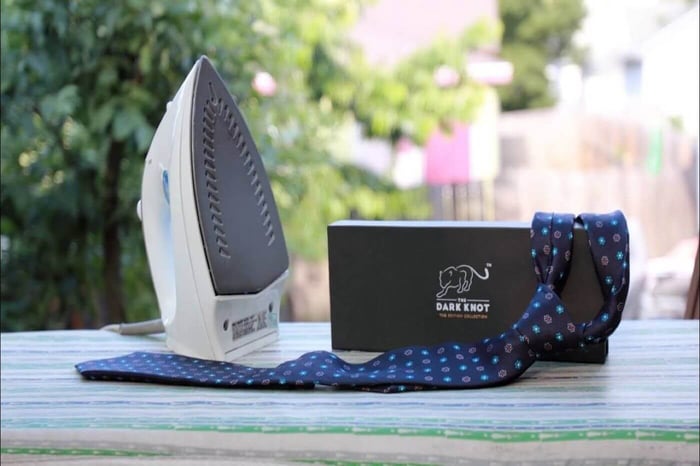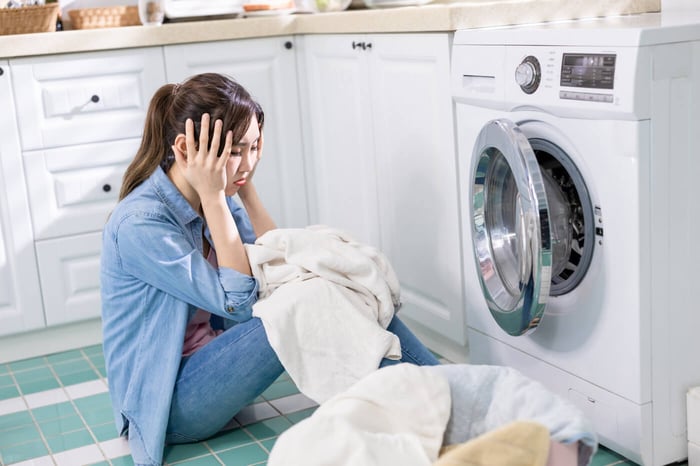
There are many different ways to clean vintage denim and old jeans. If you have been thinking about how to Clean Vintage Denim or how to make old jeans look new, the best way to clean old jeans is to hand wash the jeans and then tumble or hang dry them.
Hand-washing old jeans are the best way to clean them because it is gentler on the fabric than a washing machine. The jeans should be hand-washed in cold water with mild detergent. Tumbling or hanging the jeans to dry after washing them is also another good way to ensure that the jeans maintain their fit. Then, steam clean it with the Nori Press to make it look as good as new.
Attention: Use discount code "SHOP10" at checkout to save 10% on The Nori Press!
How to Remove Jeans Stains with 4 Simple Steps
Jeans are a wardrobe staple for many people. They are comfortable, versatile, and go with just about every outfit. But over time, jeans can get dirty and stained. If you're wondering how to make old jeans look new, the good news is that there are some easy ways to remove those stubborn stains from your favorite pair of jeans.
-
The first step to removing stains from your old denim is to soak them in warm water and dish soap for at least 30 minutes. Using hot water can cause shrinkage and fading, so it's better to use cold water.
-
Next, you want to use a scrub brush or a toothbrush to scrub the surface of the stain in circular motions while soaking the soapy jeans in water.
-
Once you have scrubbed the stain as much as possible, rinse it off with cold water
-
Let the jeans air dry overnight before wearing them again.
How to Disinfect Your Denim so You Can Wear Them Again
Denim is a popular fabric that people love to wear, but it can be hard to keep them clean. If you wear denim often, you may have noticed that they start to smell and even develop mold. This is because denim is porous and bacteria can get into the fabric.
Here are some tips on how to clean vintage denim and disinfect them!
-
Fill a large pot with water and add 1 cup of bleach. Soak your jeans in the solution for 10 minutes before washing them in the washing machine with detergent. Machine washing can affect the color and indigo of the denim, so it's important to turn your jeans inside out and use a gentle cycle to minimize fading.
-
If you don’t want to use bleach, mix 1 tablespoon of baking soda with 2 cups of water and soak your jeans for 10 minutes before washing them in the washing machine with detergent.
-
For stubborn stains, try rubbing a mixture of equal parts vinegar and hydrogen peroxide onto the stain. Let it sit for about 15 minutes, then wash as usual.
-
To remove grease from denim, rub a small amount of baby oil into the fabric and let it sit overnight. The next day, rinse out the excess oil with cold water.
-
Use a dryer sheet or towel to absorb any moisture that has built up inside the pocket.
-
If you have an ironing board, place your jeans over it and run a steam cycle. This will help loosen any creases.
-
If you find yourself constantly having to rewash your jeans because they smell bad, try adding a few drops of essential oils like lavender, lemon, orange, or peppermint.
How To Wash Vintage Jeans on a Gentle Cycle Without Ruining Them
The tips below will help you wash your vintage jeans without ruining them.
-
If your jeans are dirty, soak them in cold water with a little bit of detergent for about 15 minutes before washing them. This will help remove any stains that may be on the surface of the fabric.
-
Add a cup of white vinegar to the wash cycle to keep denim from fading and keep color from running.
-
Turn jeans inside out before washing and use cold water on a delicate cycle or hand-wash in cold water to avoid shrinkage.
-
Hang dry denim outside or lay flat in a cool, dark place to avoid fading and mold growth.
-
For raw denim, hand wash with a gentle cleanser, avoid wringing out the denim, gently roll them up to remove excess water, and line dry to maintain the custom fit.
Common Mistakes When Washing Old Denim and How To Fix Them
Many people don’t realize that denim jeans are a type of fabric. They are made of cotton and need to be washed in a certain way to extend their life.
The most common mistakes when washing old denim are not using the right detergent, not using enough water, and not turning them inside out before putting them in the washing machine.
To properly wash black jeans, turn them inside out, use cold water, and select the gentle cycle. It is also important to use a specially formulated detergent for dark colors and wash black jeans with other darker colors to prevent bleeding onto lighter-colored clothing.
How To Identify A True Vintage Pair of Jeans and How To Take Care Of Them
Jeans are a wardrobe staple for most people. If you're lucky enough to find a vintage pair at a thrift store, or you've inherited them from your parents or grandparents, it's important to know how to take care of them.
1) Identify your jeans as vintage by looking for the following: - For example, the waistband label is “Levi's” and says “Made in the USA.” - The pockets are sewn on with copper rivets. - They have a fabric tag that says "Levi Strauss & Co.
2) Wash your jeans inside out and tumble dry on low heat.
3) Gently launder the inside seam with mild detergent and cold water.
4) Rinse well, spin dry, and lay flat to dry. Steam iron using the Nori Press to remove wrinkles.
5) Store your jeans in an air-tight plastic bag to help preserve their condition.
6) Keep your denim away from direct sunlight to prevent fading.
Attention: Use discount code "SHOP10" at checkout to save 10% on The Nori Press!
Conclusion
The article offers a comprehensive guide on how to clean vintage denim. It also discusses the importance of washing them as well as the best practices for vintage denim. This article concludes with a few FAQs (below) that you can review to learn more about taking care of vintage jeans.
FAQs
Can you Machine Wash Vintage Jeans?
Can I just throw vintage jeans into the washer with some detergent and let it run through the cycle? Or should I handwash them first? Thanks!
You can definitely do this - just make sure to follow these steps to wash jeans and maintain their color and fit:
-
Soak the jeans in warm water with a small amount of laundry soap (like Ivory). Let them sit for 30 minutes.
-
Put the jeans in the washer with regular detergent. Use a gentle cycle.
-
Run the washer until all the water has been drained.
-
Lay the jeans flat to dry. Do NOT hang them up to dry.
-
Once the jeans are completely dry, fold them inside out and iron them.
-
You can then put them in a plastic bag and keep them in a closet.
-
Don’t wear them until they are 100% dry.
-
After wearing them, wash them again if needed.
Why are My Vintage Blue Jeans Turning Yellow?
I have a pair of vintage, well-worn blue jeans that I bought in the early 1980s. They’re not brand new and they don’t fit me anymore. The denim is faded to an almost white color, but it’s still pretty dark blue. However, over the past few weeks, the color has turned from deep indigo to a pale yellowish/tan color. What happened? Is there anything I can do to fix this problem?
The process of keeping denim dark involves understanding the gradual fading of dark denim over the years. Indigo dye, which is commonly used in denim, can fade over time, but re-dyeing the denim can help maintain its darkness. Additionally, machine washing jeans and air drying them can help keep the denim dark.
This could be due to several factors. First, the dye may have changed over time. Second, the dye may have reacted with something else in the environment. Third, the dye may have been damaged during storage.
If the dye has changed, you’ll need to try to match the original color. If the dye hasn’t changed, you may want to consider rewashing the jeans.
If the dye has reacted with something else in your home or outside environment, you’ll need to remove any other items that might cause discoloration. For example, you may want to check your kitchen sink for food particles that may have caused the discoloration.
Finally, if the dye has been damaged during storage, you’ll need to repair the damage before trying to restore the color. To do so, you’ll need to soak the pants in a solution of 1 part vinegar to 2 parts water. Then rinse thoroughly.
How do I Fix Holes in My Vintage Jeans?
I have a pair of Levi's that are about 20 years old. They're not too worn out, but they've got some small holes in them and the stitching is coming apart on one side. What can I use to patch these up? I don't want to buy new ones because I like how they look and feel.
If you're looking for something to fill the holes, you can use fabric glue. Simply apply a thin layer of glue to the area where the hole is located. Allow the glue to dry completely. Then press the patch onto the area where the hole used to be.
To prevent future problems, you can either sew the patches together or reinforce the areas using thread. The easiest way to deal with this issue is to take the clothing to a tailor who will sew patches onto the clothing. Alternatively, you can use fabric glue to attach patches to the clothing.
However, if you'd like to avoid sewing or using fabric glue, you can simply cut off the damaged areas and discard them. This won't work on everything, though. For instance, if you have a hole in the pocket of a shirt, you'll need to cut around the hole and then stitch the edges together.
What About Storing Vintage Clothing?
We recently moved house and I'm having trouble finding room for all of my clothes. My husband and I have a lot of vintage clothing, including some really nice pieces. Should I just throw away the clothes that aren't worth keeping? Or should I sell them online?
You definitely shouldn't throw away your vintage clothing. In fact, you should probably hold on to as much of it as possible. There are two reasons for this: first, you never know when you might come across another piece that you like; second, you never know what kind of value your vintage clothing will eventually have.
For example, one of my favorite dresses was made by a company called "Vintage Vogue." It's a very popular style among young women today. But back in the 1970s, it wasn't as common. As a result, I paid $50 for the dress. Today, it would cost more than $1,000!
So, while you may think that you'll never see another item like that again, you never know. And even if you do find another similar dress, you'll likely pay less money for it now than you did 30 years ago.
Another reason why you should keep your vintage clothing is because it could be valuable someday. You never know when someone will start collecting vintage clothing. When that happens, you'll be able to make a profit from your collection.
Of course, there are also downsides to holding on to your vintage clothing. First, you're taking up space. Second, you're spending money on repairs. Finally, you're risking damage to your clothing. If you don't treat your vintage clothing well, you could end up with something that looks worse than it actually is.
If you decide to sell your vintage clothing, you'll want to list it on eBay or Etsy. These sites allow people to buy and sell goods directly through their websites. They also provide free shipping options.
You need to wash your clothes more often than you do now. The reason for this is that the chemicals used in detergents will cause discoloration over time. For example, when you wash your clothes with Woolite, the dye in the clothing may be removed, leaving behind a lighter color. However, the chemical process causes the dye to become oxidized, which results in a darker color.
If you want to remove the yellowing, you'll need to wash your clothes using a different type of detergent. Try using a product like Tide Free & Clear or Dawn. These products contain no dyes or bleaches, so they won't leave any unwanted stains.
If you'd rather avoid buying new clothes altogether, try hanging your clothes outside to dry. This method works especially well for whites and light colors.
How Long Does it Take to Dry Clothes Outdoors?
My husband and I live in a country where we have a lot of wind. We have a clothesline that runs across our backyard. How long would it take for our clothes to dry after being hung out there?
It depends on the weather conditions. In general, most people recommend waiting at least 24 hours before putting your clothes in the dryer. If you live in a very hot climate, however, you might only need 12-18 hours.
Is it a Good Idea to Dry Clean Vintage Jeans?
I have some old Levi's that I bought at the thrift store. They are in pretty bad shape, but they still fit me and look ok from the front. The back pockets are torn out, so I can't wear them like this anymore. I was wondering if it would be better to wash them or dry clean them.
I don't know how much of an issue this is going to be, but I'm worried about the acidity of the cleaners used by dry cleaning companies. Is there anything else I should consider?
Dry cleaning is definitely not recommended for vintage items. It's possible that the chemicals used in these machines could damage your clothing. Instead, you should handwash your clothes or try green dry cleaning .
Wondering how to make old jeans look new? After handwashing, you can steam iron your vintage jeans using the Nori Press to remove the wrinkles. Get your Nori Press here !



![How to Get Highlighter Out of Clothes [20 DIY Tips] – Nori Press](https://dropinblog.net/cdn-cgi/image/fit=scale-down,width=700/34243516/files/featured/Highlighting_report_risk_of_stain_on_clothes.jpeg)




